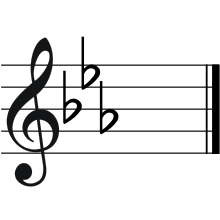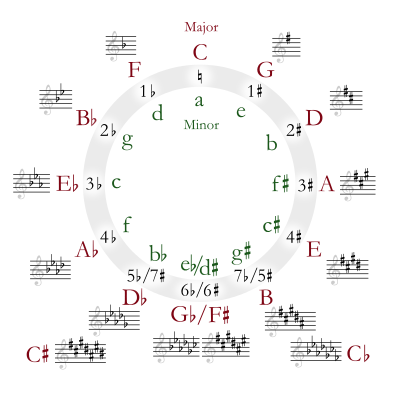C minor
 | |
| Relative key | E♭ major |
|---|---|
| Parallel key | C major |
| Dominant key | G minor |
| Subdominant | F minor |
| Component pitches | |
| C, D, E♭, F, G, A♭, B♭, C | |
C minor (abbreviated c or Cm) is a minor scale based on C, consisting of the pitches C, D, E♭, F, G, A♭, and B♭. The harmonic minor raises the B♭ to B♮. Changes needed for the melodic and harmonic versions of the scale are written in with naturals and accidentals as necessary.
Its key signature consists of three flats. Its relative major is E-flat major, and its parallel major is C major.
Usage
In the Baroque period, music in C minor was usually written with a two-flat key signature, and some modern editions of that repertoire retain that convention.
Of the two piano concertos that Mozart wrote in a minor key, one of them (No. 24, K. 491) is in C minor.
C minor has been associated with heroic struggle since Beethoven's time. Beethoven wrote some of his most characteristic works in the key of C minor, including the Symphony No. 5 and no fewer than three piano sonatas. (See Beethoven and C minor.)
Brahms's first symphony and first string quartet were composed in C minor; these were both genres with which Beethoven was closely associated during Brahms's lifetime.
Three of Anton Bruckner's ten numbered symphonies are in C minor, as are two of Dmitri Shostakovich's symphonies.
Notable compositions
- Passacaglia and Fugue in C minor, BWV 582 – Bach
- Cello Suite No. 5, BWV 1011 – Bach
- The Musical Offering, BWV 1079 – Bach
- Great Mass in C minor – Mozart
- Piano Concerto No. 24 – Mozart
- Piano Sonata No. 8 (Pathétique) – Beethoven
- Piano Concerto No. 3 – Beethoven
- Symphony No. 5, Beethoven
- Choral Fantasy, Op. 80 (1808) – Beethoven
- Piano Sonata No. 32 – Beethoven
- Piano sonata No. 1 – Chopin
- Étude Op. 10, No. 12 (Revolutionary) – Chopin
- Nocturne in C minor, Op. 48, No. 1 – Chopin
- Rondo Op. 1 – Chopin
- Prélude Op. 28/20 – Chopin
- Symphony No. 1 – Brahms
- String quartet op. 51/1 – Brahms
- Piano trio No. 3 – Brahms
- Piano quartet No. 3 – Brahms
- Symphony No. 3 (Organ Symphony) – Saint-Saëns
- Symphony No. 1 – Bruckner
- Symphony No. 2 – Bruckner
- Symphony No. 8 – Bruckner
- Piano Concerto No. 2 – Rachmaninoff
- Symphony No. 2 "Auferstehung" – Mahler
- String quartet No. 8 – Shostakovich
- Symphony No. 4 – Shostakovich
- Symphony No. 8 – Shostakovich
See also
External links
![]() Media related to C minor at Wikimedia Commons
Media related to C minor at Wikimedia Commons
| Diatonic scales and keys | |||||||||||||||||||||||||||||||||||||||||||||||||||||||
|---|---|---|---|---|---|---|---|---|---|---|---|---|---|---|---|---|---|---|---|---|---|---|---|---|---|---|---|---|---|---|---|---|---|---|---|---|---|---|---|---|---|---|---|---|---|---|---|---|---|---|---|---|---|---|---|
 |
| ||||||||||||||||||||||||||||||||||||||||||||||||||||||
| The table indicates the number of sharps or flats in each scale. Minor scales are written in lower case. | |||||||||||||||||||||||||||||||||||||||||||||||||||||||